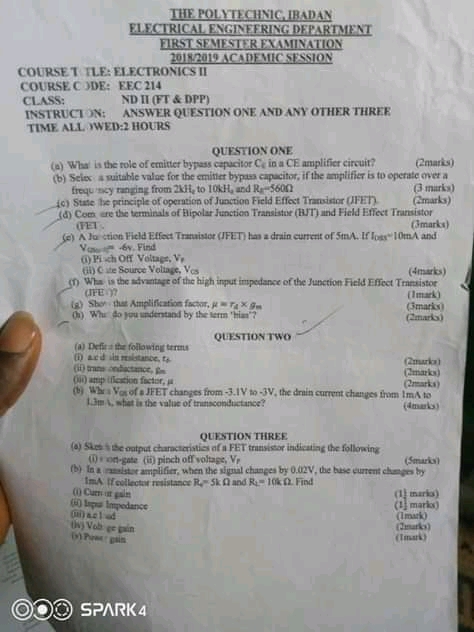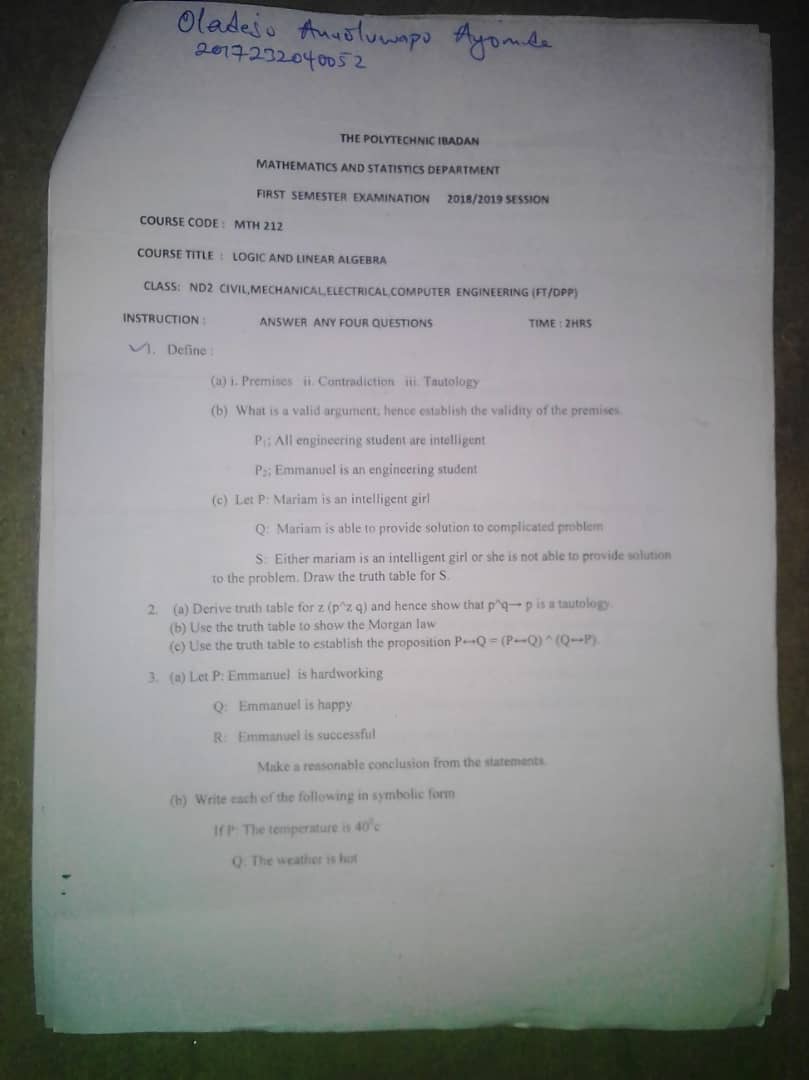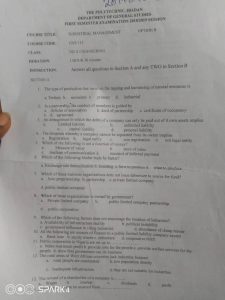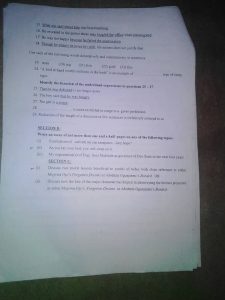ELECTRONICS II
COURSE CODE: EEC 214
COURSE TITLE: ELECTRONICS II
CLASS: ND2 ELECTRICAL ENGINEERING DEPARTMENT
electronics for nd2
ELECTRONICS II for nd2 electrical polytechnic
Electrical Engineering Department (NDll)
Course title :Electronics ll
Course code:EEC 214
Solved past question .
QUESTION ONE
Define faithful application.
State the principle of operation of JFET transistors.
Of what advantage is the high input impedance of JFET.
Compare in a tabular for the terminals of FET and BJT.
State 5 advantages of FET.
Use the figure below to answer question f and g.
What is the role of the emitter by pass capacitor CE
Select a suitable value for the emitter by pass capacitor for the circuit above if the amplifier is to operate over a frequency range from 2KHz to 10K
QUESTION TWO
-
a) Define the following terms and parameter for JFET.
-
I) AC drain resistance, r
-
ii) Irans conductance, g
iii) Amplification factor,
(b) State the relationship between the terms in (a) above.
(C) when a reverse gate voltage of 15V is applied to a JFET, the gate current is 10-3. Find the resistance between gate and source.
QUESTION THREE
-
a) Sketch the output characteristics of a FET transistor indicating the following,
(I) short-gate drain current.
(ii) Pinch off voltage.
(b) Write the expression for the drain current in FET.
(c) A JFET has the following parameters IDSS=32mA, VGS(OFF) =-8V, VGS=-4.5 find the value of the drain current, ID.
QUESTION FOUR
(a) State three (3) application of JFET.
(b) State two (2) reasons for transistor biasing.
(c) In a transistor amplifier, when the signal changes by 0.02V the base current change by 10 and collector current by 1mA. If collector load Rc=5K and RD=10K find;
-
Current gain
-
Input resistance.
-
C load.
-
Voltage gain.
-
Power gain.
QUESTION FIVE
(a) What is Quiescent point?
(b) Define amplification
C(I) State three (3) transistor configuration you know.
(ii) identify the configuration in c(i) above that exhibit all type of gain.
(d) A change in drain voltage of 2V produces a change in drain current of 0.02mA. Find the A.C drain resistance.
QUESTION SIX
(a) Define the following terms;
(i) D.C load line.
(ii) A.C load line.
(b) Draw the circuit of a practical single stage transistor amplifier and explain the function of each component.
. THE POLYTECHNIC, IBADAN
DEPARTMENT OF ELECTRICAL ENGINEERING
FIRST SEMESTER EXAMINATION 2016/2017 ACADEMY SESSION
COURSE TITLE: ELECTRONIC 11
COURSE CODE: EEC 214. CLASS:ND11
TIME ALLOWED: 2 HOURS.
INSTRUCTION: ANSWER QUESTION ONE AND ANY OTHER THREE
QUESTION AND ANSWER
QUESTION ONE
FIELD EFFECT TRANSISTOR
There are basically two types of transistors
-
Bipolar junction transistor (BJT) :- a current controlled device in which output characteristics are controlled by base current
-
Field effect transistor (FET) :- output characteristics controlled by input voltage i.e. electric field
Types of FET
-
Junction Field Effect Transistor (JFET)
-
Metal oxide semiconductor Field Effect Transistor (MOSFET)
The two types of transistor differ in both their operating characteristics and their internal construction.
BJT is so called because both holes and electrons plays part in the conduction process
Principal Disadvantages Of The BJT
-
It has low input impedance because of the forward biased emitter junction. Although low input impedance problem may be improved by careful design and used of more than one transistor.
-
it has a considerable noise level.
Difference Between JFET and BJT
-
Only one type of carrier, holes in p – type channel and electron in n- type channel in JFET WHILE electron and holes takes part in conduction in BJT
-
JFET has high input impedance since the input circuit is reversed biased WHILE input circuit for BJT is forward biased hence it has low input impedance
-
No current enters gate of JFET i.e. IG = 0 WHILE BJT base current is of few µA
-
JFET uses voltage applied on gate to control current between drain and source WHILE BJT uses current applied to base to control a large current between the collector and the emitter
-
In JFET there is no junction as in BJT. Conduction through an n –type or p – type semi conductor material for this reason noise level in BJT is very small
CONSTRCTIONAL DETAILS OF JFET
A JFET consists of a p-type or n-type silicon bar containing two pn junctions at the sides as shown in the Figure below. The bar forms the conducting channel for the charge carriers. If the bar is of n-type, it is called n-channel JFET and if the bar is of p-type, it is called a p-channel JFET. The two pn junctions forming diodes are connected internally and a common terminal called gate is taken out. Other terminals are source and drain taken out from the bar. Thus a JFET has essentially three terminals which are gate (G), source (S) and drain (D)
.
Principle of Operation Of JFET
The JFET operates on the principle that width and hence resistance of the conducting channel can be varied by changing the reverse voltage VGS.
The two p-n junction of the sides from two depletion layers. Current conduction by the charge carriers is through the channel between the two depletion layers and out of the drain. The width and hence resistance of this channel can be controlled by changing the output voltage VGS. The greater the reverse voltage VGS, the wider the depletion layers and narrower will be the conducting channel. The narrower channel means greater resistance and hence source to drain current decreases. Reverse is the case when VGS decrease. The magnitude of Is can be charged by alternating VGS.
Working Of JFET
When a voltage VGS is applied between drain & source terminals and Vas is zero, the two p-n junction at the sides of the bar establish depletion layers. The electrons will flow from source to drain through a channel between the depletion layers. The size of these layers determine the width of the channel and hence the current conduct through the bar.
When a reverse voltage VGS is applied between the gate and source, VGS the width of the depletion layers is increased. This reduce the width of the conducting channel thereby increasing the resistance of n – type bar. Consequently the current from source to drain is decreased.
NOTE:- The resistance of the channel depends on it area of x – section current from source to drain can be controlled by the application of an electric field on the gate.
IMPORTANCE CHARACTERISTICS OF JFET
-
Higher input impedance
-
Generate less noise
-
High resistance to nuclear radiation
FEATURES OF JFET
-
It is a 3 – terminal voltage controlled semiconductor device i.e. input voltage controls the output characteristic
-
It is always operated with Vas p-n junction reversed biased.
-
Gate current, IG = 0A. Hence ID = IS.
-
JFET is not subject to thermal runaway when the temperature of the device increase
-
The drain current ID is controlled by changing the channel width
-
No β rating for JFET because of since IG = 0








Reviews
There are no reviews yet.